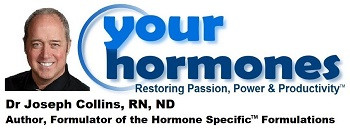
Hormone Health Protocol Questions
Question: My question is about vitamin B12. You mention in your book that vitamin B12 is needed to make both adrenal and sex hormones.
What about the cyanocobalamin form of B12? Is it safe? Does it have cyanide?
Answer: The Truth about Cyanocobalamin & “Cyano” Molecules.
There is a lot of undue concern about the form of B12 called cyanocobalamin. And I have to admit that I was thrown off for a moment. I had been concerned. However, thinking back to naturopathic medical school, I really appreciate the hours I spent studying organic chemistry.
Before I go any further, keep in mind that organic chemistry is the science that defines the structure of every organic molecule in our bodies. This naming of organic molecules follows international rules, so no matter where you go in the world; you are talking about the same molecule.
Now, we have to keep in mind that organic chemistry uses the "functional group approach" in order to name organic molecules. These functional groups have names like “ketone” or “alcohol” as well as “cyano”.
“Cyano” is a term use in organic chemistry for the functional group that consists of a carbon atom joined to a nitrogen atom by a triple bond. The term “cyano” is used interchangeably with the term “nitrile”.
Chemically, the structure may be written as: R-CΞN , with a triple bond between the C and the N, or it may simply be written as shown as: R-CN.
“Cyano” containing compounds occur in nature in various foods such as cabbage, cauliflower, broccollli, brussel sprouts, and bok choy as well as number of highly regarded medicinal herbs throughout the world including Passiflora edulis, Rorippa sylvestris, Dipthychocarpus strictus, Tabernaemontana elegans, Lophira alata, Lophira alata (jojoba) , Purshia tridentata, Hernandia nymphaefolia, Mallotus repandus, Trewia nudiflora, and others, as well as a number of medicinal sea sponges.[1] Cyano containing compounds are also found in the seeds of certain seeds and stone fruits such as apple, mango, peach, and bitter almonds.
So, while cyanocobalamin contains a functional group called “cyano” (or “nitrile”), we can see that these types of compounds exist in a number of foods and medicinal herbs. We should not be concerned about the “cyano” component any more than we should be concerned about the cobalt is in the hydroxycobalamin, methylcobalamin and cyanocobalamin.
By Joseph Collins, RN ND
